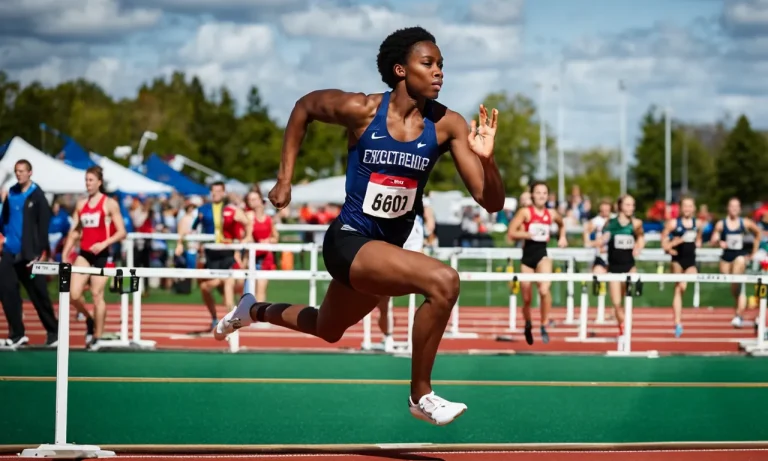Cross country running is an exciting fall sport for high school athletes looking to test their endurance outdoors. Races take place on winding trails and grassy fields over set distances. If you’re new to the sport, you may wonder – how far do high school cross country runners race?
Here’s a quick overview if you’re pressed for time: standard high school cross country races are 5K or 3.1 miles for boys and girls. Some junior varsity or freshman races may be shorter, around 2-3 miles.
This guide will breakdown the typical race distances for high school cross country meets. We’ll cover course lengths for varsity, JV and freshman races for both boys and girls.
Varsity Boys and Girls Races
5K or 3.1 mile courses
One of the standard cross country race distances for high school varsity boys and girls races is the 5K or 3.1 mile course. This distance is commonly used in high school cross country competitions across the country.
The 5K distance provides a challenging and competitive race for athletes, testing their endurance and speed. It allows runners to showcase their abilities and push themselves to their limits.
View this post on Instagram
Two miles is too short for varsity
While two miles may be a common distance for junior varsity races, it is considered too short for varsity races in high school cross country. Varsity races are typically longer to provide a greater challenge for experienced and elite runners.
The longer distance of 5K or 3.1 miles allows for a more strategic race, with runners having to pace themselves and make tactical decisions to maintain their speed and energy throughout the race.
3.1 miles prepares runners for 5K road races
Running a 3.1-mile race in high school cross country prepares athletes for future 5K road races. The 5K distance is a popular choice for road races, from community fun runs to competitive races. By participating in 3.1-mile races during their high school years, runners develop the stamina, mental toughness, and race strategies needed to successfully complete and compete in 5K road races.
This experience can be valuable for aspiring runners who plan to continue their running careers beyond high school.
Junior Varsity Race Distances
Junior varsity (JV) cross country races typically cover distances ranging from 2 to 3 miles. These distances are shorter compared to the standard race distances for varsity runners, which are usually around 5 kilometers (3.1 miles).
The purpose of having shorter distances for JV races is to allow less experienced runners to compete and gradually build their endurance and skill level.
Usually between 2-3 miles
The specific distance of JV races may vary depending on the organizer and the level of competition. However, it is common for these races to be set between 2 and 3 miles. This distance provides a challenging yet manageable course for younger runners who may be new to the sport or still developing their running abilities.
It allows them to participate and gain valuable race experience without being overwhelmed by the longer distances of varsity races.
Allows less experienced runners to compete
The shorter distances of JV races provide an opportunity for less experienced runners to compete and improve their skills. These races are often seen as a stepping stone for athletes who are new to the sport or are still developing their endurance and technique.
By participating in JV races, these runners can gradually progress to longer distances and more competitive levels as they gain confidence and experience.
May help prevent injuries
Another benefit of having shorter distances for JV races is that it may help prevent injuries, especially for younger and less experienced runners. Running longer distances requires a certain level of physical fitness and endurance, and pushing inexperienced athletes to race the same distances as varsity runners could increase the risk of injuries.
By gradually increasing the distances as athletes progress from JV to varsity, coaches and organizers can help ensure the safety and well-being of the runners.
Freshman Races Are Typically Shorter
When it comes to cross country races for high school freshmen, the distances are usually shorter compared to races for older students. This is done to gradually introduce these new runners to the sport and help them build up their endurance over time.
Around 2-2.5 miles for freshman boys and girls
Typically, freshman boys and girls will compete in races that are around 2-2.5 miles in length. This shorter distance allows them to get a taste of the sport without overwhelming them with the full 3.1-mile distance that is standard for high school cross country races.
Eases new high school runners into the 3.1 mile distance
By starting with shorter races, freshman runners can gradually work their way up to the 3.1 mile distance. This gradual progression allows them to adjust to the physical demands of longer races and build their endurance over time.
It also helps to prevent injuries that could occur if they were immediately thrown into the full race distance.
Builds endurance progressively
Progressively increasing the race distances for freshman runners helps them build endurance in a safe and effective manner. It allows their bodies to adapt to the demands of longer races, both physically and mentally.
By gradually increasing the distance, these young runners can develop the necessary stamina and mental toughness to tackle the full 3.1 mile distance in later years of high school.
View this post on Instagram
It’s important for coaches and athletes to remember that every runner is different, and some freshmen may be ready to tackle the full 3.1 mile distance right away. However, the common practice of starting with shorter races and gradually increasing the distance is widely recognized as a beneficial approach for introducing new high school runners to the sport of cross country.
Course Differences for Boys and Girls
Boys and girls run the same distances
When it comes to cross country races in high school, both boys and girls typically run the same distances. This is to ensure fairness and equal opportunities for both genders. Running the same distances allows for a level playing field and encourages healthy competition among all participants.
No differences in varsity, JV or freshman course lengths
Another important aspect to note is that there are no differences in course lengths between varsity, junior varsity (JV), or freshman races for both boys and girls. Whether you’re a seasoned varsity runner or just starting out as a freshman, you’ll be covering the same distance as your counterparts.
This allows athletes to track their progress and compare their performance with others in the same category.
View this post on Instagram
Distances may vary slightly due to course layout
While the standard distances remain the same for boys and girls, it’s worth mentioning that there might be slight variations in the actual distances due to the layout of the course. Factors such as terrain, elevation changes, and obstacles can influence the overall distance covered in a race.
However, race organizers make sure to adhere to the designated distances as closely as possible, ensuring a fair and consistent experience for all participants.
For more information on cross country race distances and guidelines for high school athletes, you can visit the National Federation of State High School Associations (NFHS) website. They provide comprehensive resources and rules for various high school sports, including cross country.
Conclusion
While some junior varsity and freshman cross country races may be shorter, the standard distance for most high school varsity cross country meets is 5K or 3.1 miles. This allows experienced runners to build speed and endurance over an appropriate distance.
Knowing what to expect for course lengths at different levels can help high school cross country runners set goals and train effectively.






